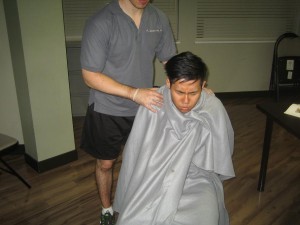What is Shock?
Any illness or injury can be accompanied by shock. Shock is a circulation problem where the body’s tissues do not get enough blood. If the shock gets bad enough, this can lead to unconsciousness or even death. Since there is often shock in an emergency situation, and because it can progress very quickly, always check for shock and assess whether it is bad enough to be a medical emergency. Shock can be life-threatening and you should phone for an ambulance immediately if you suspect someone is experiencing shock.
The Signs of Shock

- Pale skin (eventually turning blue)
- Bluish-purple lips and tongue
- Cold and clammy skin
- Irregular or shallow breathing
- Weak, rapid pulse
The Symptoms of Shock
- Anxious
- Disorientated
- Dizzy
- Very thirsty
- Restless
Minimizing the Shock of a Casualty
Provide appropriate first aid and reassure the casualty. Minimize pain by handling the casualty gently and ensure that you loosen any tight clothing that could restrict the neck and chest. Shock casualties will have cold and clammy skin, so ensure they are warm by throwing a blanket over them, if possible. Extreme thirst is one of the symptoms of shock, so if a casualty is thirsty, moisten the lips with some water. It is important that they don’t consume any food or water until the paramedics arrive.
Positioning a Shock Casualty
Putting the casualty in the right position can slow the progress of shock and make the casualty more comfortable. The position you use depends on the casualty’s condition. The casualty should be as comfortable as possible in the position you use.
- No suspected head/spinal injury and fully conscious
Place the casualty on their back with feet and legs raised – this position is often called the shock position. Once the casualty is positioned, cover him or her with a blanket, to preserve body heat.
- No suspected head/spinal injury and semi-conscious
Place the casualty in the recovery position. When there is a decreased level of consciousness, airway and breathing are top priority – the recovery position ensures an open airway.
- Suspected head/spinal injury
If there might be a head or sisal injury steadily support the casualty in the position you found them and monitor airway, breathing, and circulation. This protects the head and spine from further injury.
- As injuries permit
A casualty’s injuries may not permit you to put them in the shock position. For instance, to ease breathing, place a casualty with breathing difficulty (heart attack, asthma) into the semi-sitting position. Always think of the casualty’s comfort when choosing the appropriate position.
